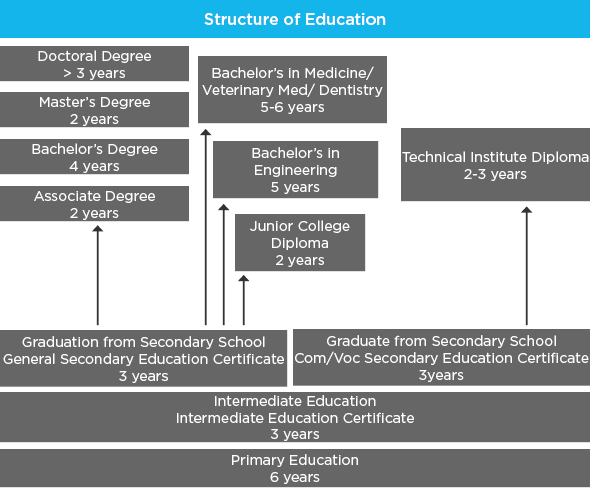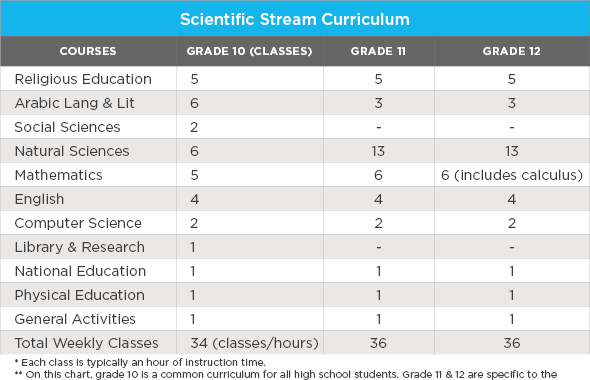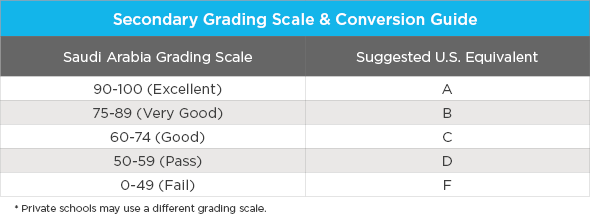Obtaining Authentic Secondary Credentials from Saudi Arabia
By Nick Clark, Editor, WENR and Ari Mihael, Assistant Director and Area Specialist, WES
Universities around the world have seen huge increases in the numbers of Saudi students enrolling on their campuses over the last half a decade, and nowhere has this been more evident than in the United States. Enrollments at the tertiary level have jumped from a base of 3,448 in 2005/06 to 22,704 in 2010/11, and 38,000 Saudi students were studying in the U.S. across all levels at the end of 2010, according to Francisco Sanchez, U.S. Under Secretary of Commerce for International Trade.
For receiving institutions, this uptick in applicant and enrollment volume has required nimble adjustments in making sure campuses are attractive and welcoming to their new Arab cohorts. This process has included both outreach efforts to the broader campus and community to ease integration, and training of international admission officers to ensure that institutions are admitting academically qualified Saudi students.
World Education Services plays a role in the credential evaluation familiarization process by providing on-campus and webinar-based training sessions for admissions offices and officers responsible for handling Saudi applicant files. In this article, we will expand on the training already provided by offering a brief primer on how best to obtain and evaluate secondary credentials from Saudi Arabia for the purposes of undergraduate admissions.
Background
Investment
The more than six-fold increase in Saudi enrollments at U.S. institutions of higher education over the last five years has been spurred in large part by the Saudi government’s recent investments in education, including huge spending on the King Abdullah bin Abdulaziz Scholarship Program. Since its inception in 2005, the program has covered the considerable costs of sending 120,000 students overseas to study at all levels of higher education at top colleges and universities across the developed world. In just its second year last April, the International Exhibition & Conference on Higher Education in Riyadh attracted more than 300 universities from across the world, all or most presumably looking for a slice of this well-funded pie.
Mainly focused on technical and medical fields, 45 percent of recipients have so far earned scholarships for undergraduate study, 21 percent master’s study, 5 percent doctoral studies, and the rest in fellowship programs, English language studies or foundation courses. Currently, 30 percent of scholarship students are in the United States, followed by 15 percent in the United Kingdom, 11 percent in Canada, 8 percent in Australia and 6 percent in Egypt. The remaining 30 percent of scholarship students are dispersed across a range of advanced education systems.
With the inclusion of some extravagantly funded projects at home – including the King Abdullah University of Science and Technology, an international research university endowed with an initial investment of US$10 billion – total investment in higher education accounted for 12 percent of the 2011 national budget, with a further 14 percent allocated to non-tertiary education. The 2011 education budget marks a 9 percent increase from the $36.69 billion allotted in 2010 and, since 2000, public spending on education has more than tripled.
Statistics
According to 2011 figures from the Ministry of Economic Planning, in 2010 the Kingdom hosted 24 public universities, 45 technical colleges (36 male-only, 9 female) and 98 vocational training centers in the tertiary sector. At the primary and secondary level, there were 4,885 secondary schools, 7,826 intermediate schools and 13,626 primary schools.
Across the whole education system there were a total of 5.15 million students, with 2.51 million enrolled in primary schools, 2.4 million in intermediate and secondary schools combined (roughly split half and half at 1.2 million each), and 903,379 in higher education, with a further 78,076 enrolled at higher technical training institutions and 16,300 at vocational training centers.
As a demonstration of the resources that the Saudi government has invested in secondary and university education over the last decade, official figures show that new enrollment at the bachelor’s level has risen from 82,075 students in 1999/00 (31,524 male, 50,551 female) to 227,725 in 2009/10 (114,222 male, 113,503 female), while overall secondary enrollment has grown from 755,977 to 1,206,348 over the same time period. At the master’s level, new entrants rose from 1,640 in 1999/00 to 8,855 in 2009/10, with an increase of 4,997 new master’s students between 2008/09 and 2009/10 alone. Total enrollment at the master’s level grew 78 percent year on year, up from 11,007 in 2008/09 to 19,952 in 2009/10.
The 2011 budget includes plans to build 610 new schools in addition to the 3,200 already under construction; 600 schools were completed in 2010. The education funds from the national budget will also support the building of new colleges and universities throughout the Kingdom and continue to support Saudi students studying abroad.
Education System
Quick Facts
- Compulsory Education: Grade 1 through Grade 6
- Academic Year: September to June
- Language of Instruction: Arabic
- Literacy Rate: 86% (UNESCO, 2009)
- Gross Secondary Enrollment Ratio: 104% (UNESCO, 2010)
- Gross Tertiary Enrollment Ratio: 37% (UNESCO, 2010)
- Saudi Tertiary Students in the United States (IIE, 2010-11)
- Undergraduate: 10,943
- Graduate: 4,609
- Other: 6,766
- Optional Practical Training: 386
Education Administration
Ministry of Higher Education (universities)
Technical and Vocational Training Corporation (TVTC) (secondary, higher technical institutes, higher commercial institutes)
Institutions and Years of Study
School
- 6 years Primary Education (age 6-12)
- 3 years Intermediate Education (12-15)
- 3 years Upper Secondary or Vocational Secondary (15-18)
- 1 Year Vocational Training Center (secondary level, based on primary or intermediate education)
Technical/Vocational
- 2-3 Year Technical College (the third year is typically practical training. Postsecondary training)
- 2-3 Years Junior College or Technical College (graduation provides entry to Higher Technical Institutes)
- 3 Year Health Institute and Nursing School
- 1-2 Year Higher Technical Institute / Financial Commercial Sciences
Higher Education
- 2 Year Junior College/Community College
- 4 Year Undergraduate
- 5 Year Engineering
- 5-6 Years Medicine/Vet/Dentistry/Law
- 2 Year Master Degree
- 3 Year Doctoral Degree
Credentials
School
- General Elementary Education Certificate
- Intermediate School Certificate (Shahadat Al-Kafa’at Al-Mutawassita)
- Secondary Education Certificate (Shahadat al-Thanawiyyah al-‘Aama or Shahadat al-Marhalat al-Thanawiyyat)
- Secondary Vocational School Diploma (Industrial, Commercial, or Agricultural) (Diplom al-Madaaris al-Thanawiyyah al-Mihaniyyah)
- Vocational Training Center Certificate (1 year secondary level course)
Vocational/Technical
- Technical College Certificate
- Associate Degree, Intermediate University Degree or Junior College Diploma
- Health Institute Diploma or Certificate of Technical Nursing
- Higher Technical Institute Diploma (1 year course with entry based on Technical College Certificate)
Higher Education
- Junior College Diploma/Associate Degree/Intermediate university Degree (These can be awarded as higher education or vocational qualifications and are offered at universities, colleges, institutes or community colleges.)
- Bachelor Degree
- Bachelor in Engineering (5 Years)
- Bachelor in Medicine/Vet/Dentistry/Law (5-6 years)
- Higher Diploma (vocational/professional focus following a bachelor degree)
- Master Degree
- Doctoral Degree
Secondary Education
At the upper secondary level, students are streamed into one of two general academic streams: Scientific and Literary (General); one of three vocational streams: Industrial, Commercial and Agricultural; or a religious stream.
Entry into specific streams happens after a common Year 10 curriculum and after the completion of intermediate education. At the end of Year 10 students are examined and those who average 60 percent or above in all subjects can choose between the scientific and vocational stream. Those averaging 50-60 must enter the literary stream. Entry to religious schooling is based on performance at intermediate school.
At the end of three years, students take the General Secondary Examination leading to the General Secondary Education Certificate (Tawjihiyah). The examination counts for 70 percent of a student’s final secondary school grade, with the remaining 30 percent being derived from prior classroom assessments.
Upper-Secondary Curriculum
- Medium of instruction is Arabic
- English language studies begin in Year 4
- Students follow national curricula. Examinations are administered and supervised by the secondary schools.
- Private secondary schools follow curricula approved by the Ministry of Education.
Grading at the secondary level tends to be towards the upper level, with a lot of high marks in the upper 80s, 90s, and even perfect scores.
Students who graduate from secondary school can apply for tertiary study depending on the stream of education completed. Graduates of religious secondary schools can only go on to study in the humanities or social sciences at university.
Required Secondary Documents Checklist
World Education Services requires the following documents from Saudi students when evaluating secondary credentials:
- General Secondary Certificate/School Transcript (last three years of upper secondary education). These transcripts are issued in English by the ministry, which performs the translation.
- The General Secondary Education Certificate (Tawjihiyah), available only in Arabic, is not required by WES, as the third year transcript comes directly from the ministry and will always indicate whether or not the student has passed and completed secondary studies and the national examination, and by extension earned the final diploma.
These documents should be obtained directly from the appropriate Regional Office of the Ministry of Education or the Technical and Vocational Training Corporation (TVTC) upon request from the student. Documents are typically sent within a few days of a student requesting them, and typically arrive by courier service. The student should initiate the request for documents and require that they are sent directly to the office evaluating them.
As noted above, secondary transcripts are dual language documents (English and Arabic), and will always be signed by the Director General of Education of the regional office of the Ministry of Education. The envelope that the documents arrive in will bear the logo of the ministry on the right hand side. In addition, the envelopes are stamped on the back flap with the stamp of the regional office of the ministry.
A list of all the regional education offices with links to the individual regional websites is available (in Arabic, but readable in English through an Internet translator) from the main ministry website (second link from the left on the top navigation bar).
The Cultural Mission of the Saudi Embassy in the United States also sends documents as a service to Saudi students getting ready to apply to U.S. universities. However, it is unclear exactly what authentication measures are undertaken by the Mission, so WES policy is to accept documents from Saudi Arabia only if they are issued from the regional offices of the Ministry of Education and sent directly to the WES office in a sealed envelope. A review of the documents will then establish if they are authentic or not.
Sample Documents
View sample documents here.
1. Secondary Education Certificate Transcript
Key information (Grade 10):
- Issued by the Ministry of Education as confirmed by the logo and title in the top and center, by way of the general directorate of the appropriate regional office (Jeddah, in this case).
- In the top right, it is noted that the document is an official translation of the Arabic document (performed by the ministry).
- This document shows grades for the student’s first year of upper secondary study (10th year of secondary studies), or “First Grade.”
- Student biographical information, including school of study, is included at the top of the transcript.
- Grade 10 courses are considered the common curriculum, so the student’s specialization is not evident from this document. Maximum and minimum passing marks, in addition to those achieved are documented. The final three grades are for ‘Activity,’ ‘Conduct,’ and ‘Attendance.’
- The document is signed by the director general of the regional office.
2. Grade 11 (Second Grade)
- Again, the document is sent by the Jeddah regional office of the Ministry of Education.
- The ‘Second Grade’ is the first year of streaming for upper secondary students. Students continue to take common curriculum subjects, while also taking a concentration of subjects in their stream. The ‘Balanced Marks’ in the final column are a reflection of the weighting each subject gets as a measure of class hours taken. In this document, it can clearly be seen that the student has a concentration in the scientific stream.
- The students overall grade for Grade 11 can be calculated by dividing total balance marks obtained and maximum possible (2186 / 3600 x 100 = 61% or a U.S. equivalent C).
3. Grade 12 (the General Secondary School Transcript)
- This is again sent by the regional office of the ministry and must be signed by the General Director of Education.
- It is a dual-language document, with a direct translation of course names from Arabic on the right to English on the left.
- The transcript shows the marks obtained in the national examination with, typically, both an obtained mark and a balanced mark, although sometimes the balanced mark will not be included. If the student achieves an overall grade higher than 60 percent in the national examination and completes all three secondary years then he or she will be awarded a general ‘Pass’ grade. Anything lower than 50 percent is a failing grade.
- The General Accumulative Average is calculated using a weighting of 30 percent secondary performance from the final two years of study and 70 percent national examination performance.
- Students have two opportunities to take the general examination. The ‘first session’ usually takes place in June and the second in September. In this case, the student “Passed in The First Session.”
4. Envelope
- The documents will arrive in an envelope marked with the dual-language details of the relevant ministry.
- Typically, the envelope will not be post-marked as it will arrive in a courier package sent by the ministry.
- The back flap of the envelope will be stamped with a seal of the ministry.


